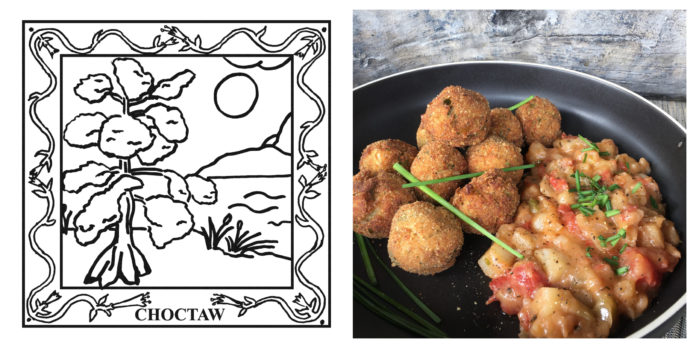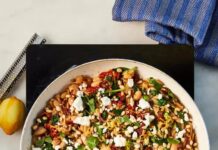
The Cullman Tribune is celebrating the Alabama Bicentennial (1819-2019) with statewide field reporting by Alabama Master Gardener/Botanical Artist Ben Johnson South. This year-long feature, “The 67-County Alabama Garden Party,” will spotlight different counties each week. Each county will get its own “quilt block,” along with a historical profile, and we’ll share a recipe specific to the area. At the end of the year, all 67 counties will be put in a book to commemorate the Bicentennial.
Choctaw County
A swamp is a wetland forested with trees, shrubs and other plant life. The hauntingly beautiful cypress swamp in Choctaw County is a main destination in the national wildlife refuge of this westernmost area of south Alabama. Aquatic plant enthusiasts and birders from across the nation flock here.
Swamps are considered a transitional zone with both land and water playing roles in creating the unique eco-environment. The two main types of swamps found in Alabama are long-standing “swamp forests” like the one in the Choctaw National Wildlife Refuge and the more common and less dramatic swampland known as “shrub swamps.”
Alabama has many swamps throughout the state. Most occur along the rivers and fluctuate in size and vegetation with the natural water levels. Other Alabama swamps are found on the shores of our large lakes.
Some Alabama swamps have dry-land protrusions called “hammocks” which are covered with aquatic vegetation like willows and sedges. To thrive, these plants must tolerate the periodic water inundation and soil saturation.
Known as a “sportsman’s Eden,” Alabama has many water-dependent marshes as well as swamps. The naturally occurring plants fishermen and hunters wade through on their search for game are typically wild grasses and reeds near the fringes of lakes and streams.
Swamps are the Rodney Dangerfield of terrains: “They don’t get no respect.” At least, swamps don’t get the appreciation they deserve. Most people think of swamps as muddy and bug-infested and a drag to paddle a canoe or a kayak through.
The next time you see an Alabama swamp remember to lift the mosquito-netting off your face and say, “Thank you.” Swamps clean up waterborne pollutants as water flows through the fine, hydroponic roots of rushes and grasses. In fact, environmentalists in our metro areas like Huntsville, Mobile and Birmingham are exploring how to create mini-wetlands called “bioswales” to filter the road runoff and divert it through plantings in storm drains.
Alabama wetlands should be preserved, not diked. Waterfront property is valuable real estate, but we should not landfill the marshes and destroy the environment. Wetland plants require water levels that fluctuate, and they act as natural flood protection by absorbing the overflow from swollen riverbanks.
Birders love Alabama. Our state’s numerous swamps and marshes like those in Choctaw County are the ideal sanctuary to see the great variety of birds that migrates and nests here.
Another advantage of slow-paddling through the cypress and willows of an Alabama swamp is the number of fish you’ll find in the fresh and brackish water. Wetlands are transitional from land to water for plants, and also for fish to transition from fresh and saltwater.
The Choctaw National Wildlife Refuge is as American as bald eagles and alligators. You’ll find both here in the wetlands. American bald eagles fly throughout all of Alabama, but American alligators have traditionally been found mostly in the coastal and inland waters of the Mobile Delta area, Choctaw County included. Alligators prefer to live in water that is 82-90 degrees Fahrenheit. Whether it’s due to global warming or over-population or a confluence of factors, adult alligators who can survive colder winters have recently been found in Alabama as far north as the Tennessee and Elk Rivers.
Alabama has many swamps to explore. Here are 10 more in counties near Choctaw: Ashtown Pond (Escambia), Beaver Dam Lake (Monroe), Beech Creek Swamp (Dallas), Big Cypress Pond (Clarke), Big Swamp (Washington), Caldwell Swamp (Baldwin), Cold Creek Swamp (Mobile), Cypress Swamp (Sumter), Moody’s Swamp (Tuscaloosa) and Sawyer Swamp (Lowndes).
There are many other pleasurable PLANTS + PEOPLE things to explore when you’re on your 67-County, Alabama Garden Party tour in Choctaw County, including our recipe for alligator appetizers:
*CHOCTAW NATIONAL WILDLIFE REFUGE (Womack Hill)- 4,281 acres with roughly half of that covered by creeks, sloughs, lakes and the backwaters of the Tombigbee River; 6.5 miles of the refuge are bordered by the river. A variety of protected wild animals and plants are to be found in the hardwood bottomlands and surrounding open fields. Managers and volunteers have placed more than 400 nesting boxes for Wood Ducks to augment the natural cavities. Get ready for miles of rustic hiking and a panorama of Instagram-ready visuals.
*CLEAR CREEK SAWMILL (Jachin)- This is timber country, and for years this business has cut logs into lumber; also, they create timber by-products such as bark, wood chips, sawdust and wood pellets.
*GEORGIA-PACIFIC PAPER MILL (Pennington)- A major employer for the area, Georgia-Pacific is one of the leading makers of tissue, pulp, paper and packaging.
*CHOCTAW COUNTY PLANT ADVICE/EDUCATION- Alabama Cooperative Extension System office, 218 South Hamburg Ave., Butler, AL 36904, 205-459-2133
*PLANTING AN IDEA- To encourage a greater appreciation of swampland, Choctaw County could be a good place to launch Alabama Swamp Appreciation Protectors (ASAP), a nonprofit to foster knowledge of wetlands and the need to protect them NOW for Alabama’s next 200 years. Is there already a Swamp Music and Food Festival in Alabama? If not, how about Choctaw County?
Y’ALL COME to Choctaw County on your 67-County, Alabama Garden Party tour! See you sooner rather than later, alligator.
Choctaw County Gator Bites with Fish Camp Swamp Gravy
Only some Alabama counties can boast of their rivers and swamps, but Choctaw County has rivers, swamps and alligators galore. No one wants a real gator bite, as in being bitten by one, but these fried Gator Bites cook up tender and tasty, even though gator is a tough meat and tougher to acquire. A good Swamp Gravy recipe is even harder to find, maybe more elusive than a gator. This adaptation is old-time, riverside, fish camp vintage, when leftover fish-fry grease was used to cook surplus vegetables into a gravy to serve with the fish. Serve Gator Bites with hot Swamp Gravy for a Choctaw County, fish camp treat.
Ingredients for Gator Bites:
- 8 oz. alligator meat (a big shout out to Sexton’s fish market in Birmingham)
- 3 green onions, diced thinly
- 1 egg, lightly beaten
- 1/4 cup flour
- Generous salt, black pepper, onion and garlic powder and red pepper flakes (to taste)
- Up to ~ 1/2 cup processed breadcrumbs
- 6 tbsp. vegetable oil
- Warmed pepper jelly – optional for serving
Ingredients for Swamp Gravy (Other surplus vegetables can be added if desired.):
- 1 grated or finely diced russet potato
- 1 diced yellow onion and 1/2 cup each chopped celery, and bell pepper
- 1 chopped, cored tomato (seeds expelled) or 1 small can diced tomatoes (drained)
- 2-3 tbsp. all-purpose flour
- Seasoning of your choice: salt, black pepper, onion and garlic powder, red pepper flakes, etc.
- Chicken broth
Instructions for Gator Bites:
- Gator is tough, so it needs to be processed. Pulse it, while chilled/semi-frozen, with the green onions in a food processor until coarsely ground, resembling ground chicken.
- Stir gator/onion mixture with beaten egg and flour (start small and add more of both as needed) and add seasonings until it forms a stiff, but still sticky mixture.
- Add some breadcrumbs and then roll ~ 1 inch gator bites, into the breadcrumbs, incorporating more crumbs, as needed, to handle.
- In ~ 2 inches of hot vegetable oil, pan fry the gator bites until golden. Drain on paper towels and keep warm until serving with swamp gravy and/or warmed pepper jelly.
Instructions for Swamp Gravy:
- Heat ~ 2 tbsp. oil from gator bite fry pan and sauté diced potatoes, onions and other vegetables until just softening. Add tomatoes and simmer. Taste and add seasonings as you cook.
- Once vegetables are soft, sprinkle with flour, stir well and add a little chicken broth; season again and simmer until vegetables are very soft and mixture is a gravy-like consistency.
Also, check out Alabama Bicentennial: 200 ways to save Alabama for the next 200 years.
Copyright 2019 Humble Roots, LLC. All Rights Reserved.






























